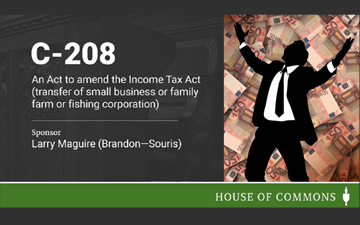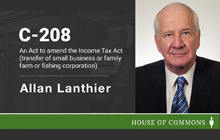Tax relief for family business transfers: A legislative fiasco – Part I

Bill C-208 has handed tax avoiders a new surplus stripping scheme on a silver platter explains tax expert Allan Lanthier in a two-part series
 |
Allan Lanthier is a retired partner of an international accounting firm, and has been an advisor to both the Department of Finance and the Canada Revenue Agency. |
Montreal – An individual who sells a business to family members often faces a heavier tax burden than would have applied on a sale to an unrelated third party.
The government has known about this issue for years: it promised to enact remedial legislation but never did. Finally, a private member’s bill — Bill C-208 — made its way through Parliament this year and received royal assent on June 29. One day later — with its back against the wall — the government announced that, later this year, it will repeal the bill with retroactive effect.[1] The Department of Finance will start drafting a new set of replacement rules to take effect on January 1, 2022. Until new rules are enacted, many family business transfers will not be able to proceed.
This article describes the attempts to fix the family business problem over the last several years, and provides a detailed, technical analysis of Bill C-208. Part II will elaborate on the government’s announcement of June 30, and give a prediction of what may lie ahead.
The problem
An individual who sells shares of a “small business corporation”[2] can benefit from a lifetime capital gains exemption (LCGE) of $892,218 (the 2021 indexed limit). The LCGE for shares of a family farm or fishing corporation is $1 million.
However, an individual who sells shares of a corporation (the “subject corporation”) to another corporation (the “purchaser corporation”) with which the individual does not deal arm’s length is subject to the surplus stripping rules in section 84.1 of the Act.[3] As a result, a sale to a corporation controlled by family members will generally result in a deemed taxable dividend to the seller rather than a capital gain, to the extent that cash or other non-share consideration received by the seller exceeds the greater of the paid-up capital and “hard tax basis” of the subject shares.[4]
Assume for example that Mr. A owns 100 percent of the shares of Co. A, a company that carries on an active business. The shares have a nominal paid-up capital and tax basis, but a substantial fair market value. If Mr. A sells the shares to an unrelated third-party he will be taxed at capital gains rates and will also have access to the LCGE. But a sale to Mr. A’s children is an entirely different matter.
If Mr. A sells the shares of Co. A to a holding company established by his children, the amount of any cash or other non-share consideration he receives will be a deemed dividend under section 84.1. This rule is in place precisely to curtail the type of surplus stripping shenanigans described further below.
Of course, Mr. A could sell the shares directly to his children (rather than to their holding company) and benefit from the normal rules for capital gains. But to pay the purchase price, the children would likely cause Co. A to pay taxable dividends to them, leaving the family unit no better off.
In short, a sale of shares to family members often results in a significant tax cost as compared with a sale to a stranger. This is the issue that Bill C-208 tried to address.
The long and winding road that lead to Bill C-208
This saga has been in process for several years. In October 2017, Finance Minister Bill Morneau announced, as part of a retreat from his much-maligned private corporation proposals, that the government would work with family businesses, including farming and fishing businesses, to make it more tax efficient to transfer a business to the next generation.[5] In fact, two private member’s bills had already tried to do exactly that, and accommodate transfers to children and grandchildren. The first bill was sponsored by a Liberal MP in 2015 when the Liberals were in opposition, and the second by a member of the NDP caucus in 2016. Both attempts failed.
The government continued to dither, and so the torch was passed to Conservative MP Larry Maguire. He cut and pasted the new bill with virtually no changes and introduced the bill a third time. And this time it passed. While the Liberal government opposed the bill because it included no safeguards against aggressive tax avoidance, it allowed a free vote. All opposition party members voted in favour of the bill, as well as 19 Liberal MPs.
The rules in Bill C-208
In general terms, the new rules provide that, if an individual sells qualified small business shares or shares of a family farm or fishing corporation to a corporation controlled by her children or grandchildren who are at least 18 years of age, she will benefit from capital gains treatment, including the LCGE, provided the purchaser corporation does not dispose of the transferred shares for at least 60 months.
The individual must provide the Minister with an “independent assessment” of the fair market value of the transferred shares and an affidavit signed by the individual and a third party attesting to the disposal of the shares.
Sounds simple enough. But in fact, the bill was riddled with loopholes and drafting errors. The problems with Bill C-208 are as follows.
Surplus strips:
Bill C-208 requires only that children or grandchildren control the purchaser corporation, and that the purchaser corporation retain the transferred shares for 60 months. This is a recipe for high-octane surplus strips that could cost hundreds of millions of dollars in lost tax revenue each year.[6]
Let’s consider Emily. Emily is a top-rate taxpayer resident in Ontario, and owns a private corporation that markets pet food (Petco). The Petco shares have a nominal tax basis and paid-up capital. The company expects to earn cash of about $1 million over the next five years. Emily has no plans to sell Petco, but would like to access the cash to purchase a villa in France.
Emily’s tax accountant tells her that, while taking a million dollars of dividends from Petco would cost her about $477,400,[7] Bill C-208 has created a new tax avoidance scheme that will allow her to access the cash for a small fraction of that amount.
A new corporation (Newco) is formed, and Emily and her daughter Sara each invest $100 in Newco. Emily receives 100 fully-participating common shares, and Sara 100 fixed-value preferred shares. The preferred shares give Sara voting control of Newco.
Emily then sells her Petco shares to Newco for a promissory note of $1 million.[8] This results in a capital gain but, after the LCGE, Emily’s tax is less than $30,000. Over the next five years, Petco pays tax-free, cash dividends of $1 million to Newco, and Newco repays the promissory note to Emily. Emily continues to operate the business and, through the common shares she owns in Newco, to fully benefit from any future earnings and increased value of the business. From her side, Sara could conceivably become involved in the business in future: however, she is studying for a medical degree so this seems unlikely.
In short, Emily has stripped $1 million out of Petco at a tax cost of less than $30,000. There is one basic test that must be met under Bill C-208: Sara must control Newco. And thanks to $100 of voting preferred shares, Sara does.
The general anti-avoidance rule:
While Bill C-208 handed tax avoiders a new surplus stripping scheme on a silver platter, would the general anti-avoidance rule (GAAR) have applied to aggressive tax avoidance plans such as our example with Emily? The answer is — probably not.
In Copthorne,[9] the Supreme Court of Canada stated that a GAAR analysis will lead to a finding of abusive tax avoidance where the transaction (1) achieves an outcome the statutory provision was intended to prevent; (2) defeats the underlying rationale of the provision; or (3) frustrates or defeats the object, spirit or purpose of the provision. But in our example with Emily, the transaction seems to achieve the precise outcome that Bill C-208 contemplates.
The Federal Court of Appeal weighed in on GAAR in the context of intergenerational transfers in Pomerleau[10] and stated that the object, spirit and purpose of section 84.1 is to prevent the removal of corporate surplus on a tax-free basis, and that nothing in the language or the object, spirit and purpose of the provision reveals an intent to accommodate surplus extractions when carried out by family members. But of course that decision was rendered before Bill C-208 was enacted. In addition, the court stated that the application of GAAR might possibly give rise to a different construction of section 84.1 to prevent its punitive result in a situation involving a fair market value sale to a corporation controlled by a family member inheriting the business.
Finally, the courts have said that there is no general policy in the Act that prohibits surplus stripping, and that such transactions do not inherently constitute abusive tax avoidance.[11]
In summary, it is unlikely that the GAAR could have been successfully applied to the type of planning in the Emily example. And as it drafts a new set of rules, the Department of Finance will no doubt recognize that a court might not apply restrictions in the context of GAAR beyond those explicitly set out in section 84.1 itself.
Sales of shares of smaller corporations:
Bill C-208 tried to restrict the benefit of the new rules to “smaller corporations”, and claw-back or deny the new relief if a corporation’s “taxable capital”[12] is between $10 million and $15 million. But the legislation was flawed and failed miserably in this attempt.
First, the rules suggest that, for purposes of applying the new relief, the individual’s LCGE should be reduced in some manner by a formula based on taxable capital.[13] But the amount of LCGE that an individual may or may not claim is not relevant for purposes of the new relief: what is relevant is whether the transferred shares are qualified small business corporation shares[14] or shares of a family farm or fishing corporation, and whether the purchaser corporation is controlled by children or grandchildren of the seller. The amount of LCGE to which an individual may be entitled is not relevant under section 84.1: in other words, the proposed restriction based on taxable capital has no application and is basically meaningless. And it is unlikely or impossible that a court would have ever concluded otherwise.[15]
Second, the claw-back in Bill C-208 uses a formula that is incorrect. It refers to a factor of 0.00225, which is two decimal places too many. As a result, even if the proposed restriction had been effective, it would have only have eliminated the new relief for corporations with taxable capital of $510 million, rather than the intended limit of $15 million.[16]
Other errors and uncertainties in Bill C-208:
Bill C-208 is only two pages long, but contains errors and uncertainties in addition to the issues described above.
For example, the ownership requirements under the bill are that children or grandchildren control the purchaser corporation, and that the purchaser corporation not dispose of the shares of the subject corporation within 60 months of their purchase. But there is nothing in the bill that prevents the children or grandchildren from selling their shares of the purchaser corporation within 60 months, or the subject corporation from selling its business.
The new relief applies even if the purchaser corporation sells the shares of the subject corporation within 60 months, provided the sale takes place “by reason of death”. But whose death exactly? A corporation may liquidate and dissolve, but it does not die.
If there is an offending disposition within the 60 month period, the new relief is deemed never to have applied and, for purposes of section 84.1, the seller is deemed to have sold the shares to the person who acquired them from the purchaser corporation.[17] The tax result is not clear, although it seems that the possible application of section 84.1 on the initial sale will be governed by the relationship of the seller and the new purchaser at the time of the second sale.
Finally, an “independent assessment” of the fair market value must be provided to the Minister, with no legislative guidance as to when or how this should be provided, or even what an “independent assessment” means.
What lies ahead?
Clearly, the provisions of Bill C-208 were in drastic need of repair. A discussion of the government’s announcement of June 30 and what may lie ahead will be the subject of Part II of this article.
Allan Lanthier is a retired partner of an international accounting firm, and has been an advisor to both the Department of Finance and the Canada Revenue Agency.
Read part two of this two-part series: Tax relief for family business transfers: A legislative fiasco – Part II.
Footnotes
[1] News Release dated June 30, 2021 from the Department of Finance.
[2] As defined in subsection 248(1) of the Canadian federal Income Tax Act (referred to herein as the “Act”). The term “small business corporation” is misleading: sales of shares of extremely large private corporations also qualify for the LCGE provided the normal tests are met.
[3] If the subject corporation and purchaser corporation are “connected” (within the meaning of subsection 186(4) of the Act) immediately after the disposition.
[4] See in particular subparagraph 84.1(2)(a.1)(ii) of the Act.
[5] News Release dated October 19, 2017 from the Department of Finance.
[6] In fact, the annual federal-provincial tax cost could conceivably exceed $1 billion a year. In 2017 (the most recent year for which data are available), close to one million tax filers received non-eligible dividends of $39.4 billion (actual amount before gross-up: estimates received by author from Statistics Canada). If, as a hypothetical example, 10 percent of this amount was converted by top-rate individuals into tax-free capital gains, the federal-provincial cost in 2017 alone would have been close to $1.8 billion.
[7] The federal-provincial rate for top-bracket individuals in Ontario is 47.74 percent for non-eligible dividends.
[8] If the fair market value of the transferred shares is greater than $1 million, Emily should also receive additional common shares of Newco, and Emily and Newco should jointly elect a transfer amount of $1 million under section 85 of the Act. If properly implemented, paragraph 85(1)(e.2) of the Act should not apply.
[9] Copthorne Holdings Ltd. v. The Queen: 2011 SCC 63.
[10] Pomerleau v. The Queen: [2019] 3 CTC 1134.
[11] See for example the decisions of the Tax Court of Canada in Gwartz ([2013] 4 CTC 2035) and Univar ([2017] 1 CTC 2214).
[12] As defined in subsections 181.2 to 181.4 of the Act.
[13]New paragraph 84.1(2.3)(b) of the Act.
[14] As defined in section 110.6 of the Act. As mentioned earlier, “small business corporations” as defined in the Act are in fact often extremely large.
[15] The courts have held that, while a contextual and purposeful analysis is useful in determining Parliamentary intent, it cannot be used to give legislative language a meaning that the language cannot bear (Federal Court of Appeal decision in Exida.com: [2010] 5 CTC 149); also, that a court can only rectify legislative drafting errors in the rarest of circumstances (Federal Court-Trial Division decision in MacMillan Bloedel: [1991] 1 CTC 204).
[16] 0.00225 X ($510 million less $10 million) giving the target result of $11, 250.
[17] New paragraph 84.1(2.3)(a) of the Act.









(0) Comments